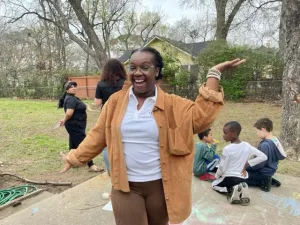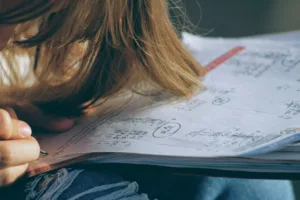My path to education entrepreneurship might seem surprising. Most of my earlier life was spent in a dance studio and on stage. I majored in ballet at the University of Utah and then discovered a love for modern dance and its creative process when I joined a professional modern dance company after graduation. After spending most of my life training in classical ballet with its specific shapes, codified steps, and very particular aesthetic, I found the process of creating modern dance invigorating. It tended to be more collaborative between dancer and choreographer, placing me as the dancer in the role of exploring, experimenting, and co-creating. You may see where the notion of co-created learning spaces that foster curiosity, exploration, and creativity became appealing to me for my own kids.
Even though I spend most of my time now directing our self-directed learning space, I still get to teach dance from time to time, and relish in the opportunity to move my body. Recently, I was asked to teach a dance improvisation class for girls ages 9–13 at a local studio. I bring a lot of my experience with the dance creative process to my work as a facilitator at The Treehouse Agile Learning Community, helping kids bring their ideas from concept to reality. But returning to the dance studio this week brought to light for me some of the reasons I think co-created learning spaces are so important for kids today.
- Permission to try an idea or make a mistake. As I watched these young dancers explore movement ideas using the prompts I offered, I noticed a lot of hesitation and inhibitions. I realized these girls have cameras pointing at them more often than I ever had at their age. Combine the possibility of photos being posted online for anyone to see at any time with the fact that traditional school values right answers over good questions, and you have a whole generation of kids who fear being wrong, looking wrong, or doing it wrong. Learning spaces that allow for experimentation and mistake-making can be a positive antidote.
- Genuine experience vs. going through the motions. One prompt I gave the students was to imagine having heavy weights on their bodies. I watched as the dancers pretended to be pressed down, seeing lots of eyes looking around uncomfortably and lots of half-hearted attempts. I paused to ask the students whether they felt genuine, and applauded them for being honest when they said no. We ended up discussing how you can give an hour of your time and pretend to do the thing, and all you will have done is spend an hour of time. The only way you grow is by really doing the thing, not just pretending. Compulsory school attendance hours teach students that being in the seat equals learning. Can we make space for kids to say, “This doesn’t feel meaningful to me. I’d rather give my time to this topic that is really fascinating to me”?
- Respectful collaboration. I started this particular class in silence. That was intentional because I wanted the dancers to follow my prompts and not be swayed by the rhythm or tone of the music. However, at one point, one brave dancer finally asked, “Can we have some music?” The whole class let out a sigh of agreement and relief. I questioned, “If music makes you more comfortable to try my ideas, why did none of you suggest that when we discussed how to feel more genuine?” Kids are not encouraged to offer suggestions, make requests, or give feedback on their experience because the teacher is seen as the authority. If we don’t let them dissent, we are robbing them of the opportunity to practice respectful collaboration. When a child expresses a different opinion in a disrespectful way, we often make them feel they are wrong for having the opinion, rather than giving them tools to express the opinion in more pro-social ways. The result is that they just stop offering the opinions, and eventually, stop engaging altogether.
- Whole-child growth happens in the context of relationships. If the end goal is just a routine where the dancers all execute matching steps, it would be faster to tell the dancers what specific move I want them to do, show it, and have them copy. However, the beautiful part of the co-creation process is that the dancers themselves each have unique ways of moving. When they take a prompt and explore it in their own way, they tend to move in ways the choreographer would never have come up with; they bring their unique gifts to the space, and the result is beautiful. Art is created and developed through the growth cycle defined by agile learning centers: intention, action, reflection, sharing. In this sense, a facilitator in a self-directed learning space acts as the choreographer; keeping the overall vision in mind to stay true to the group’s goals, but piecing together the contributions of each member into a beautiful whole. Yes, there are times when tasks just need to be done, but in our productivity-obsessed culture, we should intentionally give kids experience with slower, more reflective creative processes.
I suppose the artist in me sees education as an art, and I reject the systematizing and standardizing that has come to define it. Not all art is valued by all people, but the resulting product (and its viewer approval) isn’t always the purpose of the art. Art is about the process, and the one who benefits most from its process is its creator. If we want to raise children to become creators and critical thinkers, we need to see their education as the art of creating a life, in which the child is the central creator, and we are their partners in the process.





